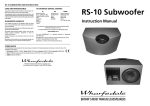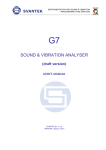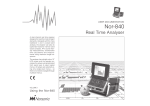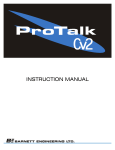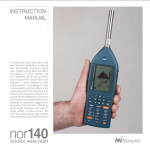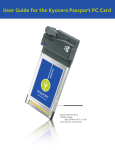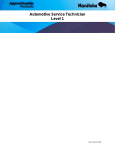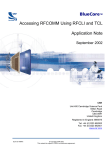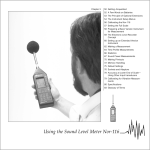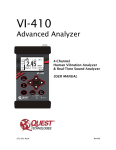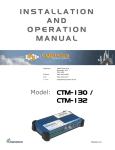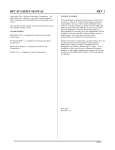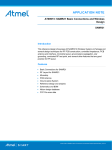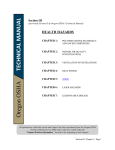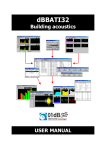Download Nor-116 User Manual - pt2
Transcript
User Documentation Sound Level Meter Nor-116 An integrating precision sound level meter with concurrent measurement of RMS and Peak using simultaneous A- and C-weighting. A large internal memory, built-in RS232 serial interface and the concept of optional extensions makes the Nor-116 a well-suited instrument for measurements within occupational health and safety, noise monitoring and noise rating of machinery. Among the multitude of optional extensions available, the meter can be equipped with RMS detection using all three time constants (F, S and I) simultaneously; with the ability to work as an electronic level recorder and the ability to calculate the sound power of a sound source based on sound pressure level measurements. IM Sound Level Meter Nor-116 Ed.2 Rev.1 English 06.99 Type 116 ON OFF INC DEC ← ← STORE 7 FUNC → → DEL CLEAR RECALL 8 9 TC NETW 4 5 6 L(t) ∆/Max ABS t 1 2 3 DIST BATTERY PRINT 0 . +/- CAL SETUP EXIT START PAUSE CONT STOP ENTER Integrating Sound Level Meter IEC 651/804 Type 1 Sound Level Meter Nor-116 June 1999 Edition Nor-116 User Documentation – June 1999 Edition Editor: Gustav Bernhard Ese, Dipl. Ing. Page Design: GRID Strategisk Design, Oslo Production Notes: This manual was created electronically on the Microsoft ® Windows NT™ 4.0 Workstation platform using Adobe PageMaker 6.51. Artworks were made with Adobe Photoshop 5, and Macromedia FreeHand 8. Proofs were made on HP LaserJet 4M and 4MV Postscript printers. RIP and final printout were made at Allkopi, Høvik, Norway. We used Palatino and Helvetica typefaces in this manual. Norsonic is a registered trademark of Norsonic AS. Windows is a registered trademark of Microsoft in the US and other countries. All other brand or product names are trademarks or registered trademarks of their respective companies. Every effort has been made to supply complete and accurate information. However, Norsonic AS assumes no responsibility for the use of – nor for the consequential damages of the use of – this information and/or the instrumentation described herein. Furthermore Norsonic AS assumes no responsibility for any infringement of the intellectual property rights of third parties, wherever applicable, which would result from such use. Norsonic AS reserves the right to amend any of the information given in this manual in order to take account of new developments. If you wish to communicate with us, please feel welcome. Our address is: Norsonic AS, P.O. Box 24 N-3421 Lierskogen Norway. Tel.: +47 3285 8900 Fax: +47 3285 2208 e-mail: [email protected] Find us on the web: www.norsonic.com Copyright © Norsonic AS 1993–99 All rights reserved Safety precautions Do not operate in an explosive atmosphere! Do not operate the instrument in the presence of flammable gases or fumes. Operation of any electrical instrument in such an environment constitutes a definite safety hazard. Keep away from live circuits! Operating personnel must not remove instrument covers. Component replacement and internal adjustments must be made by qualified maintenance personnel. Do not replace components with power cable connected. Under certain conditions, dangerous voltages may exist even with the power cable removed. To avoid injuries, always disconnect power and discharge circuits before touching them. Do not service or adjust alone! Do not attempt internal service or adjustment unless another person, capable of rendering first aid and resuscitation, is present. Do not substitute parts or modify instrument! Because of the danger of introducing additional hazards, do not install substitute parts or perform any unauthorised modification to the instrument. Return the instrument to a Norsonic Sales and Service Office for service and repair to ensure that safety features are maintained. Take care! Dangerous voltages, capable of causing death, may be present in this instrument. Use extreme caution when handling, testing and adjusting. To prevent potential fire or shock hazard, do not expose equipment to rain or moisture. Cleaning. The instrument must be switched off, disconnected from the power supply and the batteries taken out before you start to clean the instrument. Clean the instrument casing with a soft, clean cloth dampened with water. Use no other agents! Do not clean the microphone cartridge! Finding the Information You Need Type 116 ON OFF INC DEC ← ← STORE 7 FUNC 4 L(t) → → DEL CLEAR RECALL 8 TC 5 ∆/Max START PAUSE CONT STOP 9 NETW 6 ABS t 1 2 3 TBL BATTERY PRINT 0 . +/- CAL SETUP EXIT ENTER Integrating Sound Level Meter IEC 651/804 Type 1 T hank you for choosing Norsonic! The sound level meter Nor-116 has been designed to give you many years of safe, reliable operation. Your approach to the Nor-116 documentation depends on what you want to do and how much you already know. The Nor-116 User Documentation is divided into five chapters. The first four chapters deal with the noble art of measuring sound while the last chapter covers the use of the instrument, complete with specifications and remote control commands. Each chapter provides different information. Depending on your requirements and your familiarity with sound measurements as such, you may find that you use some parts of this manual often and others not at all. W e assume that you already possess some basic knowledge of measuring sound as such. However, time may have passed since you gained this knowledge. Therefore the first four chapters of this manual are devoted to technical acoustics and sound measurements. We have tried to present this using an everyday language, avoiding the use of too much mathematics (some is inevitably needed, though). Topics covered in the first four chapters include wavelength and frequency; the decibel; adding sound sources; background noise compensation; spectral weighting networks, calibration, room acoustics fundamentals; a brief introduction to noise in the workplace and the community; sound power measurements using “simple” sound level meters (simple as opposed to costly sound intensity measurement equipment) and much more. For your convenience we have also included some basic rules of for good measurement practise – see the table of contents for where to find this. C hapter five contains the actual description of the use of your Nor116 sound level meter. Note that the description applies to a fully equipped instrument. Your instru- ment may not have all the optional extensions available. The extensions may, however, be installed as retrofit at any time. Some restrictions may apply in certain markets. Consult your local dealer for more on this. The structure of chapter five is wellsuited for reference purposes, but beginners should note that the topic’s order of appearance is neither alphabetic nor arbitrary. Instead we have sorted the topics in an order reflecting the natural flow of work when using the sound level meter. In the chapter five you will also find a glossary of basic terms; the instrument specifications (in extenso); an article on the use of the Nor-116 for vibration measurements and the control commands for remote control of the sound level meter. An alphabetic list of these commands has also been included. Our main objective with this manual has been to address your goals and needs. Please let us know how well we succeeded! 5 Table of Contents 07 08 09 10 12 13 14 15 16 17 18 19 20 21 22 23 24 Sound Basics Sound versus Noise What Is Sound? Introducing the Decibel Sound Pressure versus Sound Power All Decibels Large and Small Adding Sound Sources Background Noise Compensation The Human Hearing Making Sound Level Meters Hear Sounds the Way We Do Spectral Weighting Networks Assessing the Sound Level Detector Response Time RMS, Impulse and Peak Energy Parameters – the Leq and the SEL Sound Level Meter Design Principles Calibration 27 28 29 30 31 Room Acoustics Fundamentals Anechoic Rooms Reverberant Rooms Propagation of Sound in General Propagation of Sound in Practical Rooms 33 34 35 36 38 Workplace & Community Acoustics Occupational Safety & Health Community Noise Measurements Statistics and Percentiles A Few Guidelines for Noise Reduction 39 Sound Power Measurements 40 Microphone Positions 46 Qualification Procedures for the Acoustic Environment 49 50 52 53 6 Using the Sound Level Meter Nor-116 Getting Acquainted with the Nor-116 A Few Words on Batteries The Principle of Optional Extensions 54 56 57 58 59 60 62 64 66 67 70 72 74 75 76 78 The Instrument Setup Menus Calibrating the Nor-116 Setting the Full Scale Deflection Preparing a Basic Version Instrument for Measurement The Electronic Level Recorder Concept Setting up an Extended Version Instrument Making a Measurement Time Profile Measurements Statistics Sound Power Measurements Making Printouts Memory Handling – Storing and Retrieving Memory Handling – Deleting Files and Directories Default Settings in the Nor-116 Sockets and Adaptors Accuracy at Lower End of Scale—Using Other Input transducers 79 Calibrating for Vibration Measurements 80 Specifications 83 Glossary of Terms 85 86 87 88 89 90 91 92 93 94 94 95 98 99 100 101 102 103 106 Remote Control Commands, Index, Warranty Remote Control Commands Listed Alphabetically Calibration I/O Commands Measurement Control I/O Commands Measurement Setup I/O Commands Memory Handling I/O Commands Keyboard Lockout and Simulation I/O Commands L(t) Setup I/O Commands L(t) Transfer Commands Real Time Clock I/O Commands Measurement Duration I/O Commands Misc. Transfer Commands Level Transfer Commands Sound Power I/O Commands Statistical Distribution I/O Commands Status Status Information Received with the “FS” Command If You Are Having a Problem with Your Equipment Index Chapter 1 08 Sound versus Noise 09 What Is Sound? 10 Introducing the Decibel 12 Sound Pressure versus Sound Power 13 All Decibels Large and Small 14 Adding Sound Sources 15 Background Noise Compensation 16 The Human Hearing 17 Making Sound Level Meters Hear Sounds the Way We Do 18 Spectral Weighting Networks 19 Assessing the Sound Level 20 Detector Response Time 21 RMS, Impulse and Peak 22 Energy Parameters – the Leq and the SEL 23 Sound Level Meter Design Principles 24 Calibration Type 116 ON OFF INC DEC ← ← STORE 7 FUNC 4 L(t) → → DEL CLEAR RECALL 8 TC 5 ∆/Max START PAUSE CONT STOP 9 NETW 6 ABS t 1 2 3 DIST BATTERY PRINT 0 . +/- CAL SETUP EXIT ENTER Integrating Sound Level Meter IEC 651/804 Type 1 Sound Basics Sound versus Noise W hat is the difference between sound and noise? Clearly more than the loudness only. Although an aircraft is very noisy, a mosquito at night-time can be more than enough to spoil a good night’s sleep. Instead of looking at the loudness only as a criterion for the degree of noisiness, we shall simply regard noise as what it is – viz. unwanted sound. Since noise is unwanted sound, it is closely connected with the feeling of annoyance. Noisiness is related to the loudness of a sound, which in turn must be regarded in connection with when and where it occurs (cf. mosquitos at daytime vs. nighttime). If noise becomes loud enough, the primary concern will be the risk of hearing impairment – not the annoyance. In most countries governments have issued legislation to regulate the amount of noise permitted to occur as a result of different activities – such as industry, construction work, community activities etc. The aim of such legislation is to reduce the amount of hearing impairment among the members of the community, but also to offer the same people a better life, since secondary symptoms like high blood pressure etc. often occur as a result of long time exposure to noise. 8 This calls for the ability to assess the noise level to investigate whether a) there is a risk of hearing impair present and b) any regulations have been violated. Hence noise must be measured. situation, e.g. industrial noise, must be made the same way, otherwise measurements will be incomparable. This calls for standardisation of measurement procedures. Obviously, the way you measure noise must give you the information you need to assess the noise level. Your measurement procedure may therefore depend on the type of noise you measure. All measurements made on the same type of noise Therefore, we must look into the nature of sound, as seen from a measurement point of view – which is what the following articles are all about. What Is Sound? S ound is the mechanical vibration of a gaseous, liquid or solid elastic medium through which energy is transferred away from the source by progressive sound waves. The transformation of vibrations into waves of sound… Assume a vibrating piston in a fluid medium Peak-to-peak pressure of sound wave Peak-to-peak velocity of vibrating piston This is the strict physical definition of sound. More generally we restrict the term sound to be pressure variations which can be detected by the human ear. The traditional way of measuring pressure is by means of a barometer. However, a barometer is too slow to detect the normal pressure variations in audible sound. Often, the sensitivity is too low as well. The human hearing mechanism requires that the variations occur at least 20 times a second, but not more frequent than 20 000 times a second. λ (the wavelength) Propagating wave The number of variations per second is called the frequency of the sound and is expressed in hertz (Hz). Hence, the human hearing is able to hear sound with frequencies ranging from 20 Hz to 20 000 Hz, the latter often written as 20 kHz. Note: The propagation speed of sound is ca. 340 m/s, corresponding to about 1224 kilometres per hour. Given the speed of sound propagation we are able to calculate the wavelength at a certain frequency by using the following relation: c = f × λ, in which c is the speed of sound, f the frequency and λ the wavelength. An inspection of this relation will reveal that the wavelength is inversely proportional to the frequency, i.e. low frequency means a large wavelength and vice versa. Examples: at 20 Hz the wavelength is 17 m, while at 20 000 Hz it is merely 1.7 centimetres. Of course, pressure variations with frequencies lower than 20 Hz should also be regarded as sound. They are normally referred to as infrasound. Sounds with frequencies higher than 20 kHz lie above the audible region and are referred to as ultrasound. 9 Introducing the Decibel In the early days of telephony, a frequent problem of using long wires was the severe attenuation imposed on the transmitted signal by the transmission wires. This loss of signal-strength could be so significant that even calculating the percentage of received signal compared to transmitted, resulted in a very inconvenient set of figures. Then somebody came up with the idea of taking the logarithm to the ratio between received and transmitted signal strength. µPa 100 000 000 dB 130 120 10 000 000 110 100 1 000 000 90 80 100 000 When the logarithm used is to the base of 10, the logarithm of the ratio between two amounts of power is said to be expressed in bels (B), named after Alexander Graham Bell, inventor of the telephone. However, the bel is frequently too large to be of practical use. Hence a unit onetenth of the bel was introduced, viz. the decibel. The decibel (abbreviated dB) uses – when applied to describe sound in air – the hearing threshold (20 µPa) as reference pressure. This level is defined as 0 dB. By converting sound pressure levels in pascals to decibels, a scale spanning no less than 10 000 000 : 1 is conveniently reduced to 140 : 0. Shown here is a graph indicating typical sound pressure levels for “everyday” incidents. 10 70 60 10 000 50 40 1000 30 20 100 20 10 0 Note: Physically doubling the sound pressure means to increase the sound pressure level by 6dB, while ten-folding it (×10) means to increase it by 20 dB. On the other hand, if you reduce the sound pressure by 50% (e.g. from 1 to 0.5 Pa) the level has been reduced by 6 dB, denoted as a –6 dB change, and a reduction to 1/10 corresponds to a decrease of 20 dB, denoted as a –20 dB change. Observe the use of negative signs to denote a level reduction. Calculus as we thought we knew it doesn't work with decibels. Let us look into a few aspects of this. Since the dB expresses a ratio, a variation of x dB represents the same relative variation anywhere along the dB scale. This is similar to how percentage calculations work. The similarity ends, however, when it comes to the logarithmic nature of the dB. An important fact, justifying the use of dB is the way our senses work. The sensation of hearing is like most other human senses of a differential nature. Changes are given priority rather than information on steady state conditions. However, this will only hold true as long as the level of sensation is well below levels putting your health in jeopardy. How much is a dB? As a general rule a sound pressure level variation of 1 dB is about the smallest variation detectable by the human hearing. Some extremely well-trained listeners with very good hearing have been reported to be able to detect variations down to an impressive 0.2 dB, but this is clearly an extreme case. A pressure variation of 3 dB is clearly audible, but not much more than that either. What! - 85 dB SPL just by doing this? That's right! But luckily you won't be able to hear it! With a little mathematics we are able to calculate the pressure variations at the ear due to the vertical movement when running. On the condition that the altitude difference is small, we may assume static (ambient) pressure linearity. The pressure difference between two altitudes spaced ∆h apart is given by: ∆P = ρg∆h in which ρ = density of air (1.2kg/m3) and g = acceleration caused by gravity (9.81m/s2) If we now calculate the gradient, i.e. the rate of change in pressure per unit altitude: ∂P = –ρ g = –1.2 × 9.81 [N/m3] ∂h –ρ g = –11.7 [N/m3] An SPL of 85dB (RMS) corresponds to 0.355Pa . The corresponding peak-to-peak value is obtained by multiplying the RMS value by 2√2 (sinusoidal signal) which yields a peak-topeak value of 1.006Pa. Putting this value into the above equations, solving for Dh: 1.006 ∆P = – 0.086 [m] = ∂ P –11.7 ∂h i.e. a periodic altitude variation of 8.6cm will cause a sound pressure level of 85dB! Luckily, the frequency is too low to make this audible, which shows that frequency limitations can make a lot of sense indeed! ∆h = – 11 Sound Pressure versus Sound Power L et's begin with an allegory; if you place an electrical oven in a room, connect it to the mains and turn it on, the room will gradually get warmer. The heat comes from the electrical power being transformed to heating (thermal) power and emitted by the oven. The final temperature in the room will depend on the outside temperature as well as the room size and the amount of insulation preventing the heat to “escape” from the room. For simplicity we ignore that the heat may be unevenly distributed about the room. Similarly, if you put a noise source in a room, it will emit a certain sound power which in turn will put up a certain sound pressure. The sound pressure level will depend on such things as the amount of reflections of sound from the wall, the amount of sound being transmitted into adjacent rooms (and thus not returning) etc. Again we ignore any uneven sound pressure distribution about the room. We feel temperature and prefer to use that as a criterion, rather than thermal power (ignoring radiation effects). Similarly, we hear sound pressure, rather than sound power. For assessment of hearing impair, sound pressure is the correct parameter to measure. The decibel is defined in the power domain, but through mathematics, we can also use it for sound pressure levels. Temperature (°C or K) Power (W) Sound pressure (Pa) SPL or Lp (dB) With a thermometer you can measure the heat (the temperature) in the room; while with a sound level meter you measure the sound pressure level in the room. Unless we have a special room at our disposal, we cannot use a thermometer to assess the emitted power of the electrical oven. (What we do instead is to measure the electrical power consumed by the oven. Since electrical ovens have an efficiency of 100 %, we are able to calculate the power.) 12 Sound power (W) All Decibels Large and Small W hen two completely independent sound sources are put in the same room, the resulting sound pressure is not the sum of the individual sound pressures. Instead, the resulting sound power will be the sum of the sound power emitted by each of the two sources. To provide an in-depth explanation of why this is the case is beyond the scope of this article. in the same room, but why can’t we add the two the sound pressure levels together as well? All right, you may say, sound power can be used to find the resulting noise level when two sources are brought together Sound power is proportional to the square of the sound pressure. This means that if the sound pressure is doubled (two times the initial value), the sound power is quadrupled (four times the initial value). Note: The sound power may be calculated directly from sound pressure level measurements, provided that certain precautions are made. The sound level meter 116 is capable of doing this for you – see Sound Power Measurements in this section of the manual for details. To Calculate the Level in decibels: SPL (dB) = 10 log (p2m / P20 ) SPL (dB) = 20 log (pm / p0 ) in which pm is the measured sound pressure and p0 the threshold of hearing (20 µPa). Since decibels are generally defined and not restricted to be used with sound decibels using 20 µPa as reference level are normally referred to as dB SPL (Sound Pressure Level). Note the use of squared values in the first line. This is because the decibel is defined in the power domain. However, the rules of mathematics tell that you the two equations in fact are identical. A brief discussion on this can be found in the text. This leaves us with only one option, viz. to familiarise ourselves with the sound power as well. Earlier we postulated that a dB is a dB. From the above, we may now deduce that a change of +6 dB gives a sound pressure level twice the initial and a sound power level four times the initial. In other words, for sound power levels, the dB's “count more” than they do for sound pressure levels – which justifies talking about “‘Large’ and ‘Small’ decibels”. The practical use of this knowledge is presented on the following pages. 13 Adding Sound Sources W hen you start to measure noise, you are going to encounter situations where you need to add sound pressure levels. For example, you may be engaged in noise measurements in a workshop without being able to measure with all machines running simultaneously – maybe just a few of them are running at the time. If you stay there for a while, you will get the data you for all machines, but not the overall sound pressure level in the room when all machines are running. What do you do then? Well, if you are good at mathematics, you may of course start calculating the resulting sound pressure level based on the level of each machine. The rest of us we don’t do that. There are better ways. We simply use a graph made specifically for this. The graph is shown in the fig. to the left. The graph is used to calculate the sum of two noise levels. It can be used for more sources, of course, but they must be added two and two. To add three sources, you just add two of them and the result is then added with the third. Observe that no machine must be measured more than once. Otherwise the graph procedure won’t work correctly. 14 To add two sound pressure levels coming from independent sources, a special graph is used... 3 ∆L (dB) 2 1.7 1 0 3 5 10 15 (L2 - L1 ) dB Example of use: Measure the sound pressure levels of machine Nos. 1 and 2. Assume these turn out to be L1 = 85dB and L2 = 88dB. The difference is then 88 – 85 = 3dB. Find the 3dB point along the horizontal axis. Go up until you intersect the graph and then into the vertical axis. You will find a DL value of approximately 1.7dB. Add this value to the level of noisiest machine (the sum must be louder than the noisiest) and get a resulting level of 88 + 1.7 = 89.7dB approximately 90dB! Background Noise Compensation Background noise compensations are also made by means of a dedicated graph... 6 ∆L (dB) Do not use for differences less than 3 dB! 4 2 A ssume that you are going to make measurements on a machine. If there is so much other noise present that the noise of the machine will be “drowned out”, your measurement will not reflect the noise level of the machine. Obviously the noise level of “your” machine must be higher than the background noise level. For reliable results, at least 3 dB higher. However, a correction will be needed to compensate for the influence of the background noise on the overall noise level – even if the level difference is higher than 3 dB. The “smart guy” could always calculate the compensation. The rest of us rely comfortably on the graph to the left. 0 3 5 10 (LS+N - LN ) dB Example of use: Measure the sound pressure level L S+N with machine running. Switch off machine and measure the background level LN. Assume you found these levels to be LS+N = 72dB and LN = 65dB. The difference between these amounts to LS+N – LN = 72 – 65 = 7dB. Locate this on the horizontal axis, go up until you intersect the graph and then go to the vertical axis to the left. In this case you will DLN = 1dB. Subtract this value from the overall level (the LS+N) and you get the machine sound pressure level, i.e. 72 – 1 = 71dB. Note: The above procedure is valid for machine measurements only. If you are going to measure what noise level a machine operator is exposed to, you should never attempt to make any subtraction of background levels. After all, an operator is exposed to all the noise. Certainly, his hearing cannot distinguish between machine noise levels and background noise levels. This graph also tells that when the level difference increases beyond 10 dB, the correction factor drops below 1 dB and therefore becomes insignificant. In many cases, the machine you want to measure, simply cannot be turned off. Paper and pulp machinery, for instance, are often so expensive that stopping them to measure the background level is out of the question. What to do then? One solution could be to attempt to stop the other machinery – i.e. the background noise and so to speak try a backdoor into the problem. The procedure will be the same, the difference is just that background level and machine level swap places in the calculations. 15 The Human Hearing W hen we deal with sound from a measurement point of view, we must also relate this to how the human hearing perceives sound as a function of frequency. Sound must have a frequency in the range 20–20 000 Hz to be audible by human beings. Strictly speaking this applies only to young and healthy human beings as the ability to hear high frequency sounds deteriorates with age (presbycusis). Nevertheless, more important in this context is the fact that our hearing is not linear with respect to frequency. We do not hear sounds of different frequencies equally loud, even if they are of the same level. We express this by saying that the human hearing is frequency dependent. But, it's even more complicated than this. The frequency dependence is also level dependent! To illustrate this rather complex phenomenon, we often use a set of graphs called Loudness Curves or FletcherMunson Curves (named after those who originally made these back in the thirties). These curves shown here indicate how the perceived loudness is a function of both the frequency and the level of a sinusoidal sound signal. They tell that for some frequency regions a sound must be increased in level to appear equally loud as a sound of 1 kHz, while for other ranges, the sound must be attenuated to maintain equal perceived loudness. The frequency-range your hearing accentuates, happens to coincide with the fre- 16 quency range in which very important lingual sounds have their major spectral contents. Typically, sounds like “p” and “t” have very important parts of their spectral energy within the “accentuated” range, making them more easy to discriminate between. The ability to hear sounds of the “accentuated range (around a few kHz) is thus vital for speech communication. If we then add that this region also happens to be the most vulnerable region when it comes to noise-induced hearing impair, we clearly see the importance of noise measurements as a means to protect people's hearing. The Equal Loudness Curves are contours of equal loudness and express how much a sound level must be changed as the frequency varies, to maintain a certain perceived loudness... dB Phon 130 130 110 110 90 90 70 70 50 50 30 30 10 ...The unit used is called phon. At 1 kHz, the phon and dB SPL values are identical. As frequency varies, the phon follows the contour curve while the dB remains constant... 10 20 200 1k 20 k dB Phon 130 130 110 110 90 90 70 70 50 50 30 30 10 If we turn the contour curves upside down, the curves tell to what extent the human hearing attenuates some parts of the audible frequency range (the frequency spectrum) while accentuating other parts. 10 20 200 1k 20 k Making Sound Level Meters Hear Sounds the Way We Do Sound level meters must be made to correlate with the human hearing. However, an “ideal” sound level meter neither attenuates nor accentuates any part of the audible frequency range… …this is normally referred to as a sound level meter having a flat frequency response, i.e. it puts no emphasis or weight on any part of the audible frequency range… A flat or linear frequency response, i.e. it does not vary with frequency dB 10 0 -10 -20 -30 …but bearing in mind the nature of the human hearing, the level readings of an “ideal” sound level meter are not going to correlate very well with the perceived loudness… …hence a sound level meter must be made to correlate better. To achieve this, we design the meter to put more weight on certain parts of the frequency spectrum than others, very much in the same way as the hearing itself does. An electronic circuit is often referred to as a network which is why the weight-applying circuit is commonly referred to as a “spectral weighting network”. Originally a total of four different networks (denoted A, B, C and D) were developed, but today only two are used, viz. A and C. Tip: -40 -50 20 200 1k 20 k The C-weighting differs from flat (linear), substituting one for the other will not give identical results Spectral weighting curves approximate the way the human hearing works – see text for details dB C-weighting -10 -20 -30 A-weighting -40 -50 20 sound level meter (abbreviated SLM) must be designed so that it hears the sound level very much the same way as humans do. An ideal sound level meter neither attenuates nor accentuates any part of the audible frequency range. It is then said to have a flat frequency response. For obvious reasons an ideal SLM cannot be used for hearing impair risk assessments since it doesn't hear sounds the way we do. This calls for a need to approximate the way the human hearing works. The unlinearities of our hearing can also be expressed as that our hearing puts more emphasis or weight on some parts compared to other parts. Hence an electronic circuit – often referred to as a network – doing very much the same, could be called a weighting circuit or a weighting network. An SLM with a weighting network built-in, can then be used to make weighted measurements. To make measurements comparable, the hearing approximations – normally called weighting curves – have been standardised. 10 0 A 200 1k 20 k Telephones have a frequency range of approximately 200–2 000Hz. Above 2 000Hz there is very little information present. This means that a significant part of an important frequency range is missing, which in turn explains why it is so difficult to spell over the phone without employing phonetic alphabets (like “alpha”, “bravo”, “charlie”, “delta” etc.). Originally, four different weighting curves were made to reflect the fact that the human hearing has a level-dependent frequency dependence. The four curves approximates the hearing at different levels and were called A, B, C and D. Measurements made with a weighting network employing weighting curve A, are then said to be A-weighted measurements. 17 Spectral Weighting Networks H istorically, the most well-known spectral weighting networks have been designed to be used as follows: The difference between the A-weighted and the C-weighted levels gives you information about the spectral properties of the sound you’re measuring. In connection with this, two things should be noted… • The A-curve has been designed to follow approximately the equal loudness curve of 40 phons. dB • The B-curve has been designed to follow approximately the equal loudness curve of 70 phons. 18 C-weighting 0 -10 C–A>0 C–A<0 -20 -30 • The D-curve has been designed to match the perceived noise for such things as single event aircraft noise measurements. However, the C-weighting is now being brought back to life again—not because of correlation properties hitherto overlooked, but simply because of its shape. The difference between the sound pressure level measured with A-weighting employed and the sound pressure measured with C-weighting employed will tell you something about the spectral properties of the sound you’re measuring. 2. All weighting curves have the same value at 1kHz (0dB attenuation) 10 • The C-curve has been designed to follow approximately the equal loudness curve of 100 phons. The equal loudness curves were based on measurements using pure tones. It soon turned out that with the exception of the A-curve, none of the approximations correlated very well with the perceived loudness of real-world complex sounds. Hence, all but the A-curve were eventually abandoned and up to recently, this has been the only weighting curve used. 1. The C-weighting is not identical to Flat (linear), substituting one for the other will give results that differ! A-weighting -40 -50 20 200 1k 20 k Consider the level difference C – A. If C – A > 0, the spectrum is dominated by low– frequency sound components – simply because the C-curve attenuates less than does the A-curve in the frequency region below 1kHz. However, if C – A < 0, the spectrum is dominated by high–frequency sound components. The more negative this latter value is, the higher in frequency the dominant part is located. If the difference is very small, the dominating component will be located around 1kHz. Tip: When working with noise control your noise abatement measures will depend entirely on the spectral properties of the noise. High–frequency noise is much easier to cope with than low–frequency noise. However, improvements effective on high–frequency noise are generally not effective on excessive low–frequency noise. The normal procedure is then to make a frequency analysis using fractional octave filters (typically using 1/ 3 octave filters). It is beyond the scope of this book to look further into that subject. Observe, however, that what you do by looking at the difference between the C– and the A–weighted level is in fact a miniature frequency analysis. Assessing the Sound Level The meter deflection must be fast enough to follow the fluctuations in the sound itself, yet slow enough to enable a read-out of the level… The signal itself If the deflection is too slow, peaks like this may pass totally unnoticed Meter deflection due to damping M ost sounds that you're going to measure fluctuate in level. That immediately leaves you with two problems – how to measure these variations as accurately as possible, and how to be able to end up stating that the sound pressure level turned out to be, say 58 dB in a given situation? The practical world is filled with tradeoffs – you can’t always get it the way it ideally should be. Instead you’ll have to look for quality and features sufficient to match the purpose, i.e. the errors or shortcomings introduced by the method or technology used should have as little significance as feasible for practical, economical or technical reasons. In order to be able to compare measurements made with different sound level meters, the meters must have the same amount of damping of the meter deflection. The damping is called time constant. Consider a sound level meter with an analogue display (a deflecting needle or a bargraph). If the sound level fluctuates too rapidly, the needle or bargraph change so erratically that it is impossible to get a meaningful reading. On the other hand, if we introduce a damping of the needle deflection to slow down its movements and thus make it produce more meaningful results (to us, that is), we run the risk of missing rapid changes in the sound level. Obviously, if two sound level meters have different damping of the needle deflection, they will not give identical readings of the sound level when exposed to the same sound field. To circumvent this problem, standardised detector response times have been introduced. 19 Detector Response Time A sound level meter is always equipped with a detector. The purpose of the detector is to convert the measured sound pressure to a sound pressure level (a number of decibels above the threshold of hearing – which is 20 µPa). Time constants impose damping on the detector response time… Two detector response times have been standardised. These are F (for fast) and S (for slow). Sound pressure (Pa) Sudden change at detector’s input By detector response time we mean how rapidly the detector output signal changes for a sudden change in the detector input signal. The correct term for detector response time is time constant. 1 F (Fast) If the detector input signal changes suddenly, the time constant expresses the time it takes for the detector output signal to reach 63 % of its final value. S (Slow) time (ms) The F has a time constant of 125 milliseconds and provides a fast reacting display response enabling us to follow and measure not too rapidly fluctuating sound levels. The S time constant, on the other hand, has been set to be eight times as slow – viz. one second. This will help to average out the display fluctuations on an instrument with a needle or bargraph, and make readings possible in situations where the F time constant setting would produce fluctuations impossible to read. 20 Tip: There is a way to circumvent this problem of display fluctuations. Most modern sound level meters have digital displays where the sound level is presented as figures. These figures are typically updated once per second and indicate the sound level at the moment of sampling with the selected time constant. RMS, Impulse and Peak The relationship between peak and RMS… To permit the peak value to be read out, precision sound level meters like the Nor-116 normally incorporate a Peak Hold function storing the peak value. A term you will encounter frequently when measuring sound, is the RMS, or the root mean square, value. The RMS value is a special kind of mathematical average value which is directly related to the energy contents of the sound. The energy contents of the sound is a fundamental part of hearing impair risk assessments. Peak The signal itself RMS However, if the sound to be measured consists of impulses or contains a high proportion of impact noise, measuring RMS values with F or S time constant will not give results correlating very well with the perceived noise level. To cope with this, a third time constant called I (for impulse) has been developed. The time constant of I is 35 milliseconds, which is sufficiently short to permit detection and display of transient (rapidly changing) noise in a way resembling the human perception of sound. To enable convenient read-out the decay-time for I is 1.5 seconds. How good the RMS follows the actual signal depends on the time constant used. The shorter the time constant, the more closely the RMS will follow the actual signal. Tip: What Is the RMS? The mains (line) voltage in your country will typically be 240 or 110 VAC with a frequency of 50 or 60 Hz. This AC voltage represents energy when you use it for illumination etc. How much depends on the amount of current you draw from the mains. But even DC voltage may be used for this, i.e. the energy term is applicable for this as well. The RMS term expresses what value an existing AC-signal should have—had it been a DC-signal—to develop the same amount of energy as the DC-signal would for a given configuration. The perceived loudness is a function of the frequency and the sound level, but also a function of the sound duration. Sounds of short duration are perceived to be of a lower level than steady continuous sound of the same level. The risk of hearing impair is in general not coupled to the perceived loudness. Therefore, precision sound level meters like the Nor-116 often include a circuit to measure the peak value of the sound. 21 Energy Parameters – the LEQ and the SEL S ound is a form of energy. The risk of hearing impair depends not only on the level of the sound, but also on the amount of sound energy entering the ear. For a given sound level the amount of energy entering the ear is directly proportional to the duration of exposure. Varying sound, the corresponding LEQ and SEL values... SEL Therefore, to assess the hearing damage potential of a sound environment, both the level and the duration must be taken into account. If the level is high enough, however, the duration will be irrelevant – the hearing impair will occur almost instantly. To better understand the significance of the measured levels, we are always looking for data reduction. If we manage to boil down the data to one or a few numbers, without sacrificing the hearing damage potential or – if found to be a lower sound level – the degree of annoyance that they represent, we have succeeded. So, can we combine almost all we have discussed so far in this book? The answer is, of course, yes we can, and we do that by introducing the equivalent continuous level or the LEQ. The LEQ is the constant level which has the same energy and consequently the same hearing damage potential as the actual varying, measured sound level. SPL (dB(A) LAeq The LEQ is the equivalent continuous level, i.e. the constant sound pressure level which contains the same amount of energy as the actual varying sound pressure level. The SEL is LEQ normalised to one second, the constant level acting for one second which has the same amount of acoustic energy as the original sound. Tip: To understand the difference between RMS and the L EQ consider the following: Although they both express an equivalent constant signal containing the same amount of energy as the actual time-varying signal itself, they cannot be substituted. The LEQ expresses the linear energy average, while the RMS value expresses a weighted average where more recent events have more weight than older events. Mathematically the LEQ is defined as: T Leq = 10 log 1 T 22 ∫ 0 2 p (t) 2 p0 dt Note: A few Words more on Annotation: LA means the A-weighted sound pressure level, LAEQ, T means the A-weighted LEQ, LAEQ,T,I means the impulse- & A-weighted LEQ, LAE means the A-weighted SEL and dB(SPL) is often used to keep the “sound decibels” apart from “other decibels” Sound Level Meter Design Principles . The sound level meter Nor-116 and its main functional parts… Microphone cartridge Preamplifier A sound level meter is an instrument designed to respond to sound in approximately the same way as the human ear and to give objective, reproducible measurements of the sound pressure level. This involves restriction of the frequency range to the audible region; spectral weighting of the sound as well as the application of time constants and calculation of the equivalent continuous level. The microphone cartridge converts the acoustic pressure variations – the sound – to an equivalent electrical signal, which varies in analogy with the acoustical signal, which is why we talk about analogue signals and analogue signal processing. Display Type 116 ON OFF INC Gain setting of the amplifier DEC ← ← STORE → → DEL CLEAR RECALL 7 8 9 FUNC TC NETW 4 L(t) 5 ∆/Max PAUSE CONT STOP AC-out & serial interface socket 6 2 3 BATTERY PRINT 0 . +/- CAL SETUP EXIT Integrating Sound Level Meter IEC 651/804 Type 1 START ABS t 1 DIST In precision sound level meters like the Nor-116, the microphone used is of the condenser type, which combines precision with stability and reliability. The output signal from the microphone cartridge is quite small and needs to be amplified in the preamplifier before further processing takes place. ENTER Keyboard The dynamic range of sound – the distance between the lowest and the highest sound pressure levels occurring – is larger than the dynamic range of the sound level meter. In principle, the dynamic range of sound may exceed 140 dB, counting from the threshold of hearing – 0 dB – and up to peak values of 140 dB. Luckily, the dynamic range of a practical sound environment is generally not as high as 140 dB. In addition, for assess- ment of hearing damage potentials there is no need for such large dynamic ranges. The important thing for such measurements is to determine the equivalent level and the maximum level. A level 20 dB below the equivalent level will not contribute significantly to the equivalent level (in fact a level drop of 20 dB corresponds to a drop to 1% of the initial energy). Nevertheless, to overcome this problem the dynamic range of the instrument can be shifted up and down to be able to accommodate as much of the occurring dynamic range as possible. The shifting is made by means of changing the FSD (full scale deflection) settings (actually the gain of the amplifier is changed). This is done with the INC and DEC keys of the Nor-116. The Nor-116 calculates the A- and Cweighted Peak and RMS values simultaneously. For this it needs one C-weighting and one A-weighting network as well as one Peak and one RMS detector. After detection of the RMS and Peak values, the signals are digitised in the analogue-to–digital converter. The level signals are now represented by digital signals, which do not vary in an analogue manner any more. They are now processable by the microcomputer which also controls the display, converts the values to decibels and calculates such things as the L EQ and the C– A value. The time constant is also superimposed on the signals by the microcomputer 23 Calibration W hen you are going to make sound measurements, you will need to ensure that you measure the sound pressure level correctly. The procedure of making your sound level meter measure correctly is called calibration. For sound measurements, calibration is no less than paramount – since sometimes legal action will be taken based on the sound and noise levels measured! The use of calibrators date back to those days when it was easier to design a stable calibrator than a stable sound level meter. Fortunately, this is no longer the case – today, sound level meters are as stable as calibrators. However, the microphone is a delicate device designed to fulfil all specifications requested. Hence they are vulnerable and easily subject to damage unless great care is taken. quired and that nothing has changed during the measurement session. To calibrate a sound level meter we use what is called a sound calibrator – such as the Norsonic sound calibrator Nor1251, -1252 or -1253. A sound calibrator is designed to produce a known sound pressure level when used correctly together with the sound level meter. The actual calibration is then carried out by mounting the calibrator onto the microphone as shown below and then switch the calibrator on. Many standards require that you calibrate your sound level meter before and after the measurement session. In this way you are able ensure that all data are correctly ac- 24 Instrument mode Bargraph showing the C-weighted sound pressure level Sensitivity If the sound level meter fails to indicate the correct sound pressure level, its sensitivity is adjusted until it indicates the correct value. The sound level meter is then said to be calibrated. One may therefore say that a calibrator is just as much a device for verification of appropriate operation as it is a device for readjustment of the sensitivity of the sound level meter. As we have already pointed out, the demand for measurement results reproducibility requires measurements to be made in a standardised way. You will therefore have to act in compliance with applicable standards whenever you make a sound measurement. In case the level deviates significantly from earlier or nominal values and/or it is not possible to adjust the instrument to produce the correct results, a thorough check of the sound level meter will be needed. C-weighted sound pressure level measured with timeconstant F Numerical inputs expected When calibrating, the sound calibrator is mounted on the microphone cartridge. Example here shows the sound level meter Nor-116 and sound calibrator Nor-1251. The type of spectral weighting network applied to bargraph Calibration example of what the Nor-116 display looks like during calibration. The exact calibration procedure itself is explained later in this manual. Note: Closely connected to the level is the microphone cartridge sensitivity. The sensitivity expresses how many volts per pascal the microphone cartridge used will generate. Instead of expressing it as e.g. 50 mV/Pa we often express it as how many dB below 1V/Pa the sensitivity is. A sensitivity of 50 mV/Pa corresponds to –26 dB relative to 1V/Pa, because –26 dB corresponds to 1/20. We have talked about the need to measure correctly. As we shall see this is strictly speaking not true, since a measuring device be it a speedometer or a sound level meter can only estimate the true, real value of the parameter it is measuring. pending on their level accuracy and ability to maintain a stable level. This is to ensure that measurements made Sound Calibrator type 1252 Obviously, the sound level meter cannot be the only part of this which is “infected” by uncertainties. The problem applies to sound calibrators as well. Hence, even these have been divided into several types (called classes) de- 114.0 dB 1000 Hz National and/or international standards applicable in your country may impose restrictions on which instrument types you may use for a given measurement task. For instance, type 3 instruments are not considered usable for most applications apart from pure surveys. Sound Calibrator type 1251 Instrument Classes. According to the international standard called IEC 651, sound measuring instruments (of which sound level meters constitute a subset) should be divided into four types, depending on their accuracy. These types are: Type 0, 1, 2 & 3, with type 0 as the most accurate—i.e. with the most narrow tolerances— and type 3 as the least accurate. 114.0 dB 1000 Hz An uncertainty will always be present. The scope of the calibration is to bring this uncertainty to within given limits or tolerances. For sound level meters the width of this acceptable interval of estimates will depend on which type or class it belongs to. with high-quality precision sound level meters are not ruined by inaccurate calibration. The Norsonic product range contains three sound calibrators; from left to right, the type 1251 (type 1), the type 1252 (type 2) and the type 1253 (type 0). Table showing permissive tolerances as defined by CLASS CAL IEC 651. All tolerances in decibels. 0 ± 0.15 1 ± 0.3 2 ± 0.5 3 Tip: SLM ± 0.4 ± 0.7 ± 1.0 ± 1.5 As a general rule, the accuracy of the calibrator should match that of the sound level meter, e.g. use a class 1 calibrator with a type 1 sound level meter. However, a class 1 calibrator may, of course, be used with a type 2 meter. 25 26 Chapter 2 27 Room Acoustics Fundamentals 28 Anechoic Rooms 29 Reverberant Rooms 30 Propagation of Sound in General 31 Propagation of Sound in Practical Rooms Type 116 ON OFF INC DEC ← ← STORE 7 FUNC 4 L(t) → → DEL CLEAR RECALL 8 TC 5 ∆/Max START PAUSE CONT STOP 9 NETW 6 ABS t 1 2 3 DIST BATTERY PRINT 0 . +/- CAL SETUP EXIT ENTER Integrating Sound Level Meter IEC 651/804 Type 1 Room Acoustics Fundamentals Anechoic Rooms T he sound pressure level that you measure will depend very much on the environment in which the sound source and the sound level meters are located. In other words, the room you measure in affects the measurement results. Sometimes this is undesirable, but not always. An understanding of room acoustics fundamentals is therefore required to avoid some of the basic pitfalls of sound measurements. Let us start this brief tour of room acoustics by looking into one of the two extremes – the anechoic room. In an anechoic room the walls, ceiling and floor are covered by a highly absorptive material which eliminates reflections. This means that the sound pressure level in any given direction from the sound source may be measured without interfering reflections. Because of the absence of reflections, we say that the acoustical conditions inside an anechoic room are free-field conditions. A typical application for anechoic rooms is to investigate the directivity of a sound source, i.e. in which direction is most of the sound directed. This will typically vary with the frequency, but it is essential to keep interfering reflections out of the way, otherwise reliable measurements made with a sound level meter won’t be possible. 28 Reverberant Rooms R everberant rooms constitute the exact opposite of anechoic rooms. A reverberant room has hard, highly reflective walls, ceiling and floor to reflect the sound as much as possible. Such rooms are normally made with non-parallel surfaces to avoid standing waves and create a sound field uniformly distributed about the room. A typical application for reverberant rooms is the measurement of the total acoustic power from a sound source. If you measure the sound pressure level inside a true reverberation chamber you will find that the level at any point will be an average level due to all the reflections present. Obviously, such rooms are much less expensive to construct than anechoic rooms. Hence, they find widespread use for machinery noise investigations. The majority of rooms lie somewhere inbetween anechoic and reverberant. This means that you will find elements of the properties of both room types in the room your measurements take place. We shall therefore look somewhat more into the nature of sound propagation. 29 Propagation of Sound in General S ound propagation in air resembles very much ripples on a pond. The ripples spread out uniformly in all directions. If you look carefully you will note that the amplitude of the ripples decrease as they move further away from the source. Sound propagating freely in all directions – i.e. under free-field conditions – follows the inverse square law which says that the sound pressure drops by six decibels each time the distance from the source is doubled. If there is an obstacle in the sound path, such as a wall, a part of the sound will be reflected, other parts will be absorbed by the wall and the remainder will be transmitted through the obstacle. The ratio of reflections, absorption and transmission depends on the properties of the obstacle – the material(s) it has been made of, its size and very much the wavelength of the sound. The relationship between wavelength and frequency is presented in the article What Is Sound? at the beginning of this manual. As a rule of thumb, any obstacle must be larger than one wavelength to disturb a propagating sound wave significantly. If you use obstacles for noise control, the size of a “working” obstacle (i.e. with a size larger than a wavelength) will have to double as the frequency of the sound is halved. 30 Example: At 15 kHz the wavelength of sound in air is 2.3 cm. Bearing in mind the diameter of a ½” microphone, which is 1.27 cm, we see that even such small objects as a sound level meter microphone may disturb the sound field. Therefore precision sound level meters like the Nor116 are equipped with free-field microphones which have been designed to compensate for its own presence in the sound field to avoid incorrect results when measuring. Propagation of Sound in Practical Rooms P ractical rooms are somewhere inbetween anechoic and reverberant. You must therefore care when making measurements in rooms. If you make measurements on a machine rather far away from it, reflections from the walls and nearby objects may lead to results unsuited as an adequate descrip- The practical room is somewhere in-between an anechoic chamber and a reverberant chamber, therefore elements of both can be found in different parts of the room... Near-field Far-field Free-field Reverberant-field However, if you make your measurements too close to the machine, the sound pressure level will vary considerably with a small change in sound level meter position. This area of the sound field, called the near-field of the machine, typically extends a distance of about one wavelength of the lowest frequency emitted from the machine, or twice the greatest dimension of the machine – whichever is greater. Hence, we recommend that you look for the zone in-between these two extremes to determine the optimum position for measuring the noise omission of the machine. Sound pressure level vs. position Direct sound Typically 2 x machine's largest dimension or one wavelength tion of the machine’s noise emission. Reflections normally dominate this part of the sound field, called the reverberant field. Distance from noise source Note: Worth noting here, is that the discussion on this page applies only to situations where the machine per se is to be measured. If your task is to assess the machine operator’s noise exposure, measurements should preferably be made as close to her ears as possible, to have the instrument measure the noise level her ears are exposed to. In this zone the inverse square law is clearly applicable. It is therefore called the free-field zone. The level will normally not drop by 6 dB per doubling of distance – typical value will be between 3 and 5 dB. The reason why is that the zone is not ideally free-field – although the walls and other obstacles might be far away, the floor is generally near you, generating reflections destroying the free-field concept. If the room housing the machine is so small, or so reverberant that no free-field zone exits, you have no choice but to measure in the reverberant field (or in the near-field, if that’s the only option present). 31 32 Chapter 3 34 Occupational Safety & Health 35 Community Noise Measurements 36 Statistics and Percentiles 38 A Few Guidelines for Noise Reduction Type 116 ON OFF INC DEC ← ← STORE 7 FUNC 4 L(t) → → DEL CLEAR RECALL 8 TC 5 ∆/Max START PAUSE CONT STOP 9 NETW 6 ABS t 1 2 3 DIST BATTERY PRINT 0 . +/- CAL SETUP EXIT ENTER Integrating Sound Level Meter IEC 651/804 Type 1 Workplace & Community Acoustics Occupational Safety & Health A nother important field of sound measurements is the field of environmental noise measurements. The primary concern here is measurements of the total noise and the noise exposure of human beings, both at home and for occupational safety & health reasons. In these cases, emphasis is moved towards assessing the total noise level, irrespective of the number of sources and reflections involved. In addition the noise must be measured where the employee works. If she works in the near-field, measurements should be made in that near-field, regardless of what we talked about in A Little Room Acoustics. The presence of other machines and reflecting surfaces becomes important when we decide to take measures to bring down the noise level, but also to determine whether one ear receives more energy than the other. If that is the case, measure at the one with the highest level or measure at both, but don’t make an average of the two measurements – in general, your task is to assess the hearing damage, which you’ll fail to do if you reduce the maximum level by mixing it with lower levels to create an average level. 34 Community Noise Measurements W hen we are talking about community noise, we are thinking of noise imposed on us causing annoyance and disruption of our daily activities as well as any noise levels likely to cause quality reduction of life and environment in the future. We are not thinking of occupational safety and health, which we briefly discussed on the left page of this page spread. Community noise includes such topics as traffic noise, aircraft noise, construction noise and property boundary noise. As always, the methodology of the measurement is determined by the need for data reduction. The scope is to find the optimum trade-off between as few figures as possible and as good a representation of the annoyance as possible. Obviously, the L EQ plays an important role, together with the maximum SPL. However, there is a significant difference between these types of measurements and e.g. occupational health and safety measurements. In the latter case, the concern is primarily about hearing impair, while the former is about annoyance, i.e. a far lower level. In addition, it takes only one vehicle to spoil a good night’s sleep. Imagine how little impact a single vehicle will have on a full night LEQ measurement – next to nothing! One way of circumventing this is to apply more weight to nightly sound incidents, another is to look at the statistical distribution of the sound level. 35 Statistics and Percentiles Community noise, such as traffic noise is a type of noise we often analyse by means of statistical methods rather than by measurement of the maximum level and the average level. The scientific term applied to how wide each postbox span, is classwidth. The Nor-116 is then said to have a classwidth of 0.5 dB in its statistical analysis. Compiling data for statistical analysis of the sound level implies sampling of the noise level. To get a sufficient amount of data (in conventional statistics referred to as the need to get a sufficiently large population), the noise level is sampled 16 times per second in the Nor116. Other sound level meters may have different sampling rate. During a statistical measurement, the 116 will keep track of the number of Before we proceed, let us hasten to add that the sampling discussed here has nothing to do with the kind of sampling existing in digital instruments, computers and CD -players etc. That kind of sampling is related to the analogue-to– digital conversion needed to allow digital processing inside the instrument. Our sampling is about obtaining the sufficiently large population. We said sampling of the noise level, let us now look into what happens to these samples. The sampled noise levels are sorted like in a post office, but rather than according to their addresses, they will be sorted according to their levels. In the Nor-116. there are altogether 169 different postboxes each spanning a level of 0.5 dB. Well, all but two of them span 0.5 dB to be precise. The two who don’t are the one that accommodates all levels lower than 80 dB below full scale and the one that accommodates all levels above 3.5 dB above full scale. 36 samples which fall within each class (see the previous page for more on this), or to stick to our analogy, the number of letters within each postbox. If we wanted to, we could now have calculated the statistical distribution by looking into the relative frequency of each class. However, we won’t do that. Instead we will look into the following problem: We want to know – in simple terms – something about the distribution, but without a graph and without knowing the shape of the distribution (hence we won’t be looking for expected value and standard deviation). Ideally this should be presented with a few figures! Can we do that? Postbox analogy to illustrate the statistics sampling... Of course we can. The answer lies in calculating the percentiles. The percentile is defined as follows: The X percentile defines the sound level that was exceeded for X per cent of the time considered and is denoted L X. Consequently, the L 99 defines the level that was exceeded for 99% of the time, the L 50 the level that was exceeded for half the time and L0.1 the level that was exceeded for 0.1% of the time. Note that the L 99 is very close to the background level, since it was exceeded for 99% of the time, and similarly that the L 0.1 is very close to the maximum level since it was exceeded for only 0.1% of the time. This means that by selecting appropriate percentiles, a few percentiles can provide lots of information about how the sound was distributed over a period of time. FSD + (0 to 0.5) dB Overrange FSD + (3.0 to 3.5) dB FSD + (0.5 to 1.0) dB FSD + (3.0 to 3.5) dB FSD + (1.0 to 1.5) dB FSD + (2.5 to 3.0) dB FSD + (1.5 to 2.0) dB FSD + (2.0 to 2.5) dB For clarity, only nine classes are shown Note: A given percentile, say L5, is calculated as follows: We start by adding all samples of all classes together to find the total number of samples and then we calculate how many samples 5% will be. Since percentiles tell the amount of time the sound level exceeded some level, we then start from the top (the class containing the highest levels) and move downwards while adding the contents of the classes (the “postboxes”) until we have reached 5% of the total number of samples. The level at which this takes place is then the answer to our problem. Imagine this took place at 85.5 dB. The L5 is then 85.5 dB. 37 A Few Guidelines for Noise Reduction Suppose that you have measured sound levels too high to be acceptable, either because they cause too much annoyance or – even worse – that they are likely to cause hearing impair. What to do then? The following guidelines are recommended: • Noise should be reduced or (preferably) eliminated at its source. This may call for redesign of machinery, but also for redesign of machinery location and means of mounting. • The sound transmissions paths should be blocked by placing enclosures or acoustic screens around the machinery. • The noise control specialist would say that if you have a noise problem, your real problem is of vibrational nature. Consider mounting the machinery on vibration isolators to prevent transmission through the floor (structure-born sound). • Provide the exposed person with hearing protection. In some countries this is considered as a temporary solution only and not considered acceptable as a permanent solution. • Installation of absorptive materials may bring down the overall noise level, but for an operator working in a machine’s near-field, the procedure won’t work – simply because the reverberant field (for which the introduction of absorptions actually will work) has no influence on the near-field levels. As a noise control measure for operators it may prove useless. 38 Chapter 4 40 Microphone Positions 46 Qualification Procedures for the Acoustic Environment The difference between sound pressure and sound power is covered in the article Sound Pressure vs. Sound Power in Chapter 1 of this manual. Although this chapter also provides an abstract of the ISO 3746, we strongly recommend that you order a personal copy of the Standard and use that when making sound power measurements. Norsonic AS is not liable for any consequential loss or damage that may occur as a result of the descriptions given in this manual. Type 116 ON OFF INC DEC ← ← STORE 7 FUNC 4 L(t) → → DEL CLEAR RECALL 8 TC 5 ∆/Max START PAUSE CONT STOP 9 NETW 6 ABS t 1 2 3 DIST BATTERY PRINT 0 . +/- CAL SETUP EXIT ENTER Integrating Sound Level Meter IEC 651/804 Type 1 Sound Power Measurements Microphone Positions S ound power levels may be calculated from sound pressure level measurements using an ordinary sound level meter such as the Nor-116. The method is described in ISO 3746 Acoustics—Determination of sound power levels of noise sources—Survey method and requires measurements of the Aweighted sound pressure level at four or more microphone positions located on a hypothetical measurement surface of area S which envelopes the source. To facilitate the location of the microphone positions on the measurement surface a hypothetical reference box shall be defined. When defining the dimensions of this box, elements protruding from the source which are not significant radiators of sound energy may be disregarded. b) a rectangular parallelepiped whose sides are parallel to those of the reference box; in this case the measurement distance d is the distance between the measurement surface and the reference box. l3 One of the following two shapes shall be used for the measurement surface: a) a hemisperical surface or partial hemisperical surface of radius r; 40 Reference box on one reflecting plane d0 l2 Q ÿ = l1 + + l3 d0 The measurement surface on which the microphone positions lie envelopes the source as well as the reference box. The location of the source under test, the measurement surface and the microphone positions are defined by a coordinate system with the horizontal axes x and y in the ground plane parallel to the length and width of the reference box. The characteristic dimension d0 is shown in the Fig. to the right. For sources usually mounted and/or to be measured in rooms or spaces under unfavourable acoustical conditions (e.g. many reflecting objects and high levels of background noise), the selection of a small measurement distance is appropri- Reference box on two reflecting planes l2 Q ÿ = l1 + + l3 d0 Q l2 l1 Reference box on three reflecting planes ÿ = + + ate and usually dictates the selection of a parallelepiped measurement surface. For sources usually mounted and/or to be measured in large open areas under satisfactory acoustical conditions, a large measurement distance is usually selected and in this case the hemispherical measurement surface is preferred. For measurements on a series of similar sources (e.g. machines of the same type or a given family of equipment), the use of the same shape of measurement surface is required. A test report shall always be made and the construction of the reference box, the size and shape of the measurement surface, as well as the measurement distance d or the radius of the hemisphere r, shall be described in the test report. Hemispherical Measurement Surface The hemisphere shall be centred in the middle of the box consisting of the reference box and its images in the adjoining reflecting planes, point Q in the Figs. to the left. The radius r of the hemispherical measurement surface shall be equal to or greater than twice the characteristic source dimension d0 and not less that 1 metre. The environmental requirements state that the reflecting plane must not be of such a material or in such a condition that it radiates any appreciable sound energy due to vibration. If the measurements are made outdoors over grass- or snow-covered ground, the measurement distance shall not exceed 1 metre. The general requirement is that the sound absorption coefficient of the reflecting plane shall be less than 0.1 over the frequency range of interest. Also no reflecting objects that are not part of the source under test shall be located inside the measurement surface. Hemispherical Microphone Positions If there is only one reflecting plane, the microphone positions lie on the hypothetical hemispherical surface of area S = 2pr2, enveloping the source and terminating on the reflecting plane. If the source under test is in front of a wall, S = pr2 and if it is in a corner, S = 0.5pr2. The Fig. below shows the locations four key microphone positions, each associated with equal areas on the surface of the hemisphere of radius r. z y 10 4 5 The radius of the hemisphere should be one of the following values (in metres): 1, 2, 4, 6, 8, 10, 12, 14 or 16. Some of these radii may be too large to meet the environmental requirements given in ISO 3746. If so, such large values shall not be used. 6 l3 l2 x l1 Microphone array on the hemisphere – key microphone positions. If a source is installed adjacent to more than one reflecting plane, the Figs. shown on the next page are used to define a suitable measurement surface and the microphone positions. Additional Microphone Positions Sound pressure level measurements are required at additional microphone positions on the hemispherical measurement surface if: a) the range of sound pressure level values measured at the key microphone positions (i.e. the difference in decibels between the highest and lowest sound pressure levels) exceeds twice the number of key measurement points, or b) the source radiates noise with a high directivity, or c) the noise from a large source is radiated only from a small portion of the source, e.g. the openings of an otherwise closed machine. If condition a) exists, additional microphone positions shall be used. For the microphone array on the hemisphere, an additional 4-point array is defined by rotating the original array through 180° about the z-axis. Note that the top point of the new array is coincident with the top point of the original array. The number of microphone positions is increased from 4 to 7. Conditions b) and c) require more measurements in the region of high radiation. more… 41 Microphone Array on the Hemisphere z One reflecting plane y 10 4 4 5 15 60 ° 6 l3 20 l2 x 16 10 6 l1 Measurement surface z Reference box 14 5 0.89r 4 5 14 15 6 0.45r 16 10 20 1r Measurement surface Two reflecting planes 1 1 4 3 x 45° 5 1 Reference box 6 NB! Dimensions in metres 2 1 NB! Dimensions in metres 5 3 1 Additional microphone positions Key microphone positions are numbered 4,5,6 and 10, additional microphone positions are numbered 14, 15, 16 and 20. 42 2 Three reflecting planes 1 4 ° .5 6 22 22 Key microphone positions .5° Parallelepiped Measurement Surface The measurement distance d is the perpendicular distance between the reference box and the measurement surface. The preferred value of d is 1 m and should be at least 0.15 m. The value of d should be one of the following values (in metres): 0.15, 0.25, 0.5, 1, 2, 4 or 8. Measurement distances larger than 1 m may be selected for large sources. There are environmental requirements that should be satisfied for the value of d selected. In brief, the environmental requirements state that the reflecting plane must not be of such a material or in such a condition that it radiates any appreciable sound energy due to vibration. If the measurements are made outdoors over grass- or snow-covered ground, the measurement distance shall not exceed 1 metre. The general requirement is that the sound absorption coefficient of the reflecting plane shall be less than 0.1 over the frequency range of interest. Also no reflecting objects that are not part of the source under test shall be located inside the measurement surface. Microphone Positions The microphone positions lie on the measurement surface, a hypothetical surface of area S enveloping the source whose sides are parallel to the sides of the reference box and spaced out a distance d (measurement distance) from the box. The microphone positions on the parallelepiped measurement surface are shown on the following pages. The area S of the measurement surface according to the microphone position figures is given by the formula: S = 4(ab + bc + ca) where a = 0.5l1 + d b = 0.5l2 + d c = 0.5l3 + d l 1, l2 and l3 are the length, width and height of the reference box. If a source is installed adjacent to more than one reflecting plane, reference shall be made to the corresponding figures (also shown on the following pages. Additional Microphone Positions Sound pressure level measurements are required at additional microphone positions on the parallelepiped measurement surface if a) the range of sound pressure level values measured at the key microphone positions (i.e. the difference in decibels between the highest and lowest sound pressure levels) exceeds twice the number of key measurement points, or b) the source radiates noise with a high directivity, or c) the noise from a large source is radiated only from a small portion of the source, e.g. the openings of an otherwise closed machine. If condition a) exists, additional microphone positions shall be used. For the microphone array on the parallelepiped, the number of microphones are increased as shown on the next page by increasing the number of equally sized rectangular partial areas. Microphone array on the parallelepiped – valid for larger machines. If conditions b) or c) exist, additional measurement positions on the measurement surface in the region of high noise radiation shall be used. Details on this are given in the ISO 3746. more… 43 ≤3d ≤3d ≤3d ≤3d ≤3d An example is when the radiation pattern is shown to be symmetrical. Procedure for fixing the specified microphone positions where a side of the measurement surface exceeds 3d ≤3d Reducing the Number of Positions The number of microphones positions can be reduced if preliminary investigations for a particular family of machines show that by using the reduced number of microphone positions, the determined surface sound pressure levels do not deviate more than 1dB from those determined from measurements over the complete set of microphone positions in accordance with the procedures described above. Each plane of the measurement surface shall be considered on its own and so subdivided that the result is the smallest possible number of equal sized rectangular partial areas with a maximum length of side equal to 3d (see the Fig. to the right). The microphone positions are in the centre of each partial area. In this way the other positions shown on this page spread are obtained. More than One Reflecting Plane For a source installed adjacent to more than one reflecting plane, reference shall be made to the figures shown on this page spread for the purpose of defining a suitable measurement surface. Microphone positions are as shown in the Figs. 44 ≤3d The overhead position(s) may be omitted for safety reasons, if so stated in the relevant noise test code. Mic. Positions – One Reflecting Plane Note: The overhead position(s) may be replaced by positions at the corners of the measurement surface or may be omitted if so indicated in the relevant noise test code. Example of a measurement surface and microphone positions for a small machine… …and an example of microphone placement for a larger machine. Details on the microphone positioning can be found in the ISO 3746. d l1 l2 l3 d d d Microphone placement with four microphones for floor-standing appliances placed against a wall… …and three microphones for floorstanding appliances placed in a corner. Reference box Microphone position 45 Qualification Procedures for the Acoustic Environment A test area outdoors or an ordinary room will provide a suitable environment if the requirements given in the Annex A of the ISO 3746 and briefly outlined here are satisfied. Reflecting objects other than reflective plane(s) shall be removed to the extent possible from the vicinity of the machine under test. A test site shall ideally provide a measurement surface which lies a) inside a sound field that is essentially undisturbed by reflections from nearby objects and the room boundaries, and b) outside the near field of the sound source under test. For the purpose of the survey method (the method described here), the measurement surface is considered to lie outside the near field if the measurement distance from the source under test is equal to or greater than 0.15 m. Specific Requirements Examples of permitted reflecting planes outdoors include compacted earth, artificial surfaces such as concrete or sealed asphalt, while for indoor measurements, the reflecting plane is usually the floor. Take care to ensure that the reflecting surface does not radiate any appreciable sound energy due to vibration. on this are given in the ISO 354) of the reflecting plane should preferably be less than 0.1 over the frequency range of interest.This requirement is usually fulfilled when outdoor measurements are made over concrete, sealed asphalt or stone surfaces. For reflecting planes with higher sound absorption coefficient, e.g. grass- or snow-covered ground, the measurement distance shall not exceed 1 m. For indoor measurements, wooden and tile floors are also permitted. No reflecting parts that are not part of the source under test shall be located within the measurement surface. The K2A Factor The environmental correction factor K2A accounts for the influence of undesired sound reflections from room boundaries and/or reflecting object near the source under test. The magnitude of this factor depends principally on the ratio of the sound absorption area A of the test room to the area S of the measurement surface. The magnitude does not depend strongly on the location of the source in the test room. In the ISO 3746, the environmental correction factor K2A is given by K2A = 10lg[1 + 4(S/A)] dB The reflecting surface must be larger than the projection of the measurement surface on it. where A is the equivalent sound absorption area in the room at 1 kHz, in m2 S is the measurement surface area, in m2. The sound absorption coefficient (details Environmental corrections as a function of 46 A/S are illustrated on the next page. Approximate Method The mean sound absorption coefficient a of the surface of the room may be estimated using the table shown on the next page. The value A is given, in m2, by the formula: A = a·SV where a is the mean sound absorption coefficient, given for A-weighted quantities in the table on the next page. SV is the total area of the boundary surfaces of the test room (walls, ceiling and floor), in m2. Test Room Qualification Requirements For the measurement surface in a test room to be satisfactory for measurements in accordance with the requirements of ISO 3746, the ratio of the sound absorption area A to the area S of the measurement surface shall be equal to or greater than 1, that is A/S ≥ 1 The large the ratio A/S is, the better. If you cannot meet this requirement, a new measurement surface shall be chosen. This surface shall have a smaller total area, but shall still lie outside the near field. Alternatively you may improve the A/S by adding sound-absorbing materials to the test room. If this does not help, the test room cannot be used for ISO 3746 measurements. The environmental correction factor K2A accounts for the influence of undesired sound reflections from room boundaries and/or reflecting objects near the source under test. The magnitude of this environmental correction factor depends principally on the ratio of the sound absorption area A of the test room to the area S of the measurement surface. The magnitude does not depend strongly on the location of the source in the test room. dB 10 When measuring in accordance with the ISO 3746, the environmental correction factor K2 is obtained from this graph by entering the abscissa with the appropriate value of A/S 9 8 K2 = 10log10[1+ 4] A/S 7 6 5 4 3 2 1 0 0.5 1 5 10 50 100 300 A/S α Description of Room 0.05 Nearly empty room, smooth hard walls made concrete, brick, plaster or tile Partly empty room, room with smooth walls Room with furniture, rectangular machinery or industrial room Irregularly shaped room with furniture, irregularly shaped machinery or industrial room Room with upholstered furniture, machinery or industrial room with small amount of acoustical material Room with acoustical material on both ceilings and walls Room with large amounts of acoustical material on ceiling and wall 0.1 0.15 0.2 0.25 0.35 0.5 Calculating the A: The value of the mean acoustic absorption coefficient a is estimated by using the above table. The value of A is then given, in m 2 by A = a × SV in which SV is the total area of the surface of the test room (walls, ceiling and floor) in m2 47 48

















































